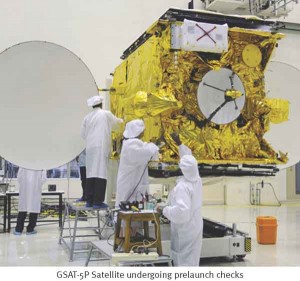What went wrong with the GSLV missions in 2010 ? The abortive GSLV-D3 mission of April 20, 2010, was attributed to failure of the turbo-pump in the indigenous cryogenic stage. A modified turbo-pump has since been successfully tested and should remedy the problem. The unsuccessful GSLV-F06 flight of December 25, 2010, was traced to design deficiency in the shroud (cover) at the bottom of the cryogenic stage. It has been recommended that the shroud should be made stronger or done away with altogether. However, these failures (and others before them) drive home the point that ISRO still has some distance to go before it can claim to have mastered cryogenic engine technology.A failure analysis committee recently found no design problems with the GSLV. ISRO has therefore decided to concentrate on developing indigenous cryogenic engines that power GSLV Mk-II launch vehicles. It is also conducting an overall audit of its GSLV programme to identify vulnerabilities before undertaking further launches; hence, significant delays in the country’s space programme can be expected. As an immediate consequence, the GSAT-7 and INSAT-3D satellites, which were scheduled to be launched by GSLV missions, will now blast off on international launchers, probably provided by Arianespace.
| Editor’s Pick |
In fact, ISRO owes much of its commercial success to Arianespace, since Indian satellites have been regularly sent into orbit courtesy Ariane launch vehicles. Starting with the APPLE experimental satellite in 1981, Arianespace has orbited 14 Indian satellites to date.
Impressive Capability
ISRO’s remote sensing and communications satellites have been outstanding successes and have rightly brought it much acclaim. It all began on March 17, 1988, with the launch of IRS-1A, the first in a series of Indian Remote Sensing (IRS) satellites. Resourcesat-2 launched April 20, 2011, is India’s 18th remote sensing satellite. And the country’s 10 satellites constitute the largest civilian remote sensing satellite constellation in the world.
 Many of the images obtained are used by government and private agencies especially for development of infrastructure like roads and airports and for town planning. The copious imagery has even created a problem of plenty. A recent report by the Comptroller and Auditor General of India (CAG) cites inordinate delays in image processing at the National Remote Sensing Centre, Hyderabad, and observes that around 90 per cent of images are not utilised—a sad waste of effort.
Many of the images obtained are used by government and private agencies especially for development of infrastructure like roads and airports and for town planning. The copious imagery has even created a problem of plenty. A recent report by the Comptroller and Auditor General of India (CAG) cites inordinate delays in image processing at the National Remote Sensing Centre, Hyderabad, and observes that around 90 per cent of images are not utilised—a sad waste of effort.
The Indian National Satellite (INSAT) system is one of the largest domestic communications satellite systems in the Asia-Pacific region. It kicked off on August 30, 1983 with the launch of INSAT-1B bringing about a major revolution in India’s communications. On May 21, 2011, the advanced communications satellite GSAT-8 was successfully launched by the Ariane-V launch vehicle from Kourou, French Guiana. The 3,100-kg GSAT-8, the heaviest and most powerful Indian satellite ever, is now part of a 10-satellite constellation (INSAT-2E, INSAT-3A, INSAT-4B, INSAT-3C, INSAT-3E, KALPANA-1, GSAT-2, INSAT-4A, INSAT-4CR and GSAT-8) in service.
These satellites, offering a total of nearly 200 transponders in the C, extended C, and Ku bands, support telecommunications, television broadcasting, weather forecasting, disaster warning as also search and rescue operations. ISRO is keen to boost its capacity further because transponders are always in demand and such satellites pay for themselves many times over. GSAT-8 is also the first to feature the GPS Aided Geo Augmented Navigation (GAGAN) equipment. GAGAN is a Satellite-Based Augmentation System (SBAS) like those in place in the US, Europe and Japan. A joint effort by ISRO and the Airports Authority of India, it is designed to aid aviation by refining GPS signals to three metres accuracy.
“¦there is a thin dividing line between a purely civilian space programme and a military one. In January 2007, China carried out a successful test of an anti-satellite weapon, showing that future war in space is a grim possibility.
The system will offer seamless satellite navigation to air traffic across the Indian Ocean region. It will also provide precision approach facility to aircraft landing at Indian airports and is likely to prove invaluable for landing in bad weather or executing approaches at “difficult” airports like Mangalore and Leh. The second GAGAN payload is scheduled to be launched on GSAT-10 during the first quarter of 2012 and the third a few months later. The GAGAN system is expected to be ready for operational use by May 2013.
Even more ambitious in scope is an autonomous regional navigation system called the Indian Regional Navigational Satellite System (IRNSS). GAGAN will support this system as well. The IRNSS will begin with seven satellites and may go on to 11. IRNSS-1, the first of the IRNSS constellation, will carry a navigation payload and a C-band ranging transponder and is planned to be launched onboard the PSLV during 2012-13. The entire constellation is planned to be functional by 2014. At present, only two space navigation systems are operational globally—the US Global Positioning System (GPS) and the Russian Global Navigation Satellite System (GLONASS). While Europe’s Galileo is expected to be up and running by 2014, China’s Beidou-2 (Compass) is scheduled to offer services over the Asia-Pacific region by 2012 and globally by 2020.
It has long been recognised that there is a thin dividing line between a purely civilian space programme and a military one. In January 2007, China carried out a successful test of an anti-satellite weapon, showing that future war in space is a grim possibility. Both China and India are enhancing their military and quasi-military space capabilities. The Chinese Beidou-2 and India’s IRNSS will be totally independent of America’s GPS and, therefore, available to guide military missions as well. India’s IRS satellites can also perform military surveillance tasks. GAGAN and IRNSS can prove invaluable for precise navigation and pinpoint targeting for a variety of military missions of all three services. In addition, each of the three Defence Services, beginning with the Indian Navy, has been promised at least one dedicated satellite to cater to its requirements. A multi-band naval satellite weighing 2,330 kg will soon be placed in geostationary orbit above the Indian Ocean and will network warships, submarines, aircraft and land-based operation centres through high-speed data links.





